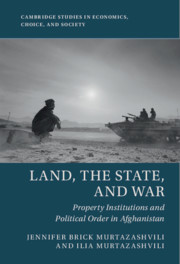Book contents
- Land, the State, and War
- Land, the State, and War
- Copyright page
- Dedication
- Contents
- Photographs and Drawings
- Maps
- Figures
- Tables
- Maps
- Acknowledgments
- Glossary
- Abbreviations
- Chronology of Events
- 1 Introduction
- 2 A Theory of Property Rights
- 3 Property Rights and State Building
- 4 Property Rights and War
- 5 Self-governance of Property Rights
- 6 Self-governance, War, and the Commons
- 7 Self-governance, Legal Titling, and the State
- 8 Are Property Rights a Cause or Consequence of Political Order?
- Appendix
- References
- Index
3 - Property Rights and State Building
Published online by Cambridge University Press: 20 August 2021
- Land, the State, and War
- Land, the State, and War
- Copyright page
- Dedication
- Contents
- Photographs and Drawings
- Maps
- Figures
- Tables
- Maps
- Acknowledgments
- Glossary
- Abbreviations
- Chronology of Events
- 1 Introduction
- 2 A Theory of Property Rights
- 3 Property Rights and State Building
- 4 Property Rights and War
- 5 Self-governance of Property Rights
- 6 Self-governance, War, and the Commons
- 7 Self-governance, Legal Titling, and the State
- 8 Are Property Rights a Cause or Consequence of Political Order?
- Appendix
- References
- Index
Summary
In Chapter 3, we consider property rights in Afghanistan from the formation of the Afghan state in 1747 through 1901, when Abdur Rahman, one of Afghanistan’s most ruthless kings, died. The Afghan state during its first century was fragmented and marred by frequent political conflict. Nonetheless, its political arrangement, which we call a de facto federation because it dispersed political power in practice but not formally, provided a political foundation for the emergence of land-use rights and vibrant trading routes. The situation was not unlike England’s de facto federation that enabled the rise of markets after the Glorious Revolution, one in which the fragmentation of political power at the national level and the rise of towns contributed to a political environment in which institutions were allowed to change in response citizens’ needs. Unlike in England, where wealth-creating economic institutions strengthened over time, these productive institutional developments in Afghanistan were reversed at the conclusion of the nineteenth century as Abdur Rahman began to consolidate political power. Our theory can explain why: because coercive and administrative capacity occurred alongside the dismantling of political constraints, consolidation of political power resulted in the destruction of private property rights and trading routes.
Keywords
- Type
- Chapter
- Information
- Land, the State, and WarProperty Institutions and Political Order in Afghanistan, pp. 38 - 64Publisher: Cambridge University PressPrint publication year: 2021

